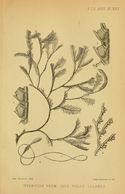Haleciidae
| Den här artikeln har skapats av Lsjbot, ett program (en robot) för automatisk redigering. (2013-01) Artikeln kan innehålla fakta- eller språkfel, eller ett märkligt urval av fakta, källor eller bilder. Mallen kan avlägsnas efter en kontroll av innehållet (vidare information) |
| Haleciidae | |
 | |
| Systematik | |
|---|---|
| Domän | Eukaryoter Eukaryota |
| Rike | Djur Animalia |
| Stam | Nässeldjur Cnidaria |
| Klass | Hydrozoer Hydrozoa |
| Ordning | Leptothecata |
| Familj | Haleciidae |
| Vetenskapligt namn | |
| § Haleciidae | |
| Hitta fler artiklar om djur med | |
Haleciidae[1] är en familj av nässeldjur. Enligt Catalogue of Life[1] ingår Haleciidae i ordningen Leptothecata, klassen hydrozoer, fylumet nässeldjur och riket djur, men enligt Dyntaxa[2] är tillhörigheten istället ordningen Hydroida, klassen hydrozoer, fylumet nässeldjur och riket djur. Enligt Catalogue of Life omfattar familjen Haleciidae 135 arter[1].
Kladogram enligt Catalogue of Life[1] och Dyntaxa[2]:
| Haleciidae | |||||||||||||||||||
Bildgalleri
Källor
- ^ [a b c d] Bisby F.A., Roskov Y.R., Orrell T.M., Nicolson D., Paglinawan L.E., Bailly N., Kirk P.M., Bourgoin T., Baillargeon G., Ouvrard D. (red.) (29 september 2011). ”Species 2000 & ITIS Catalogue of Life: 2011 Annual Checklist.”. Species 2000: Reading, UK. http://www.catalogueoflife.org/annual-checklist/2011/search/all/key/haleciidae/match/1. Läst 24 september 2012.
- ^ [a b] Dyntaxa Haleciidae
Externa länkar
 Wikimedia Commons har media som rör Haleciidae.
Wikimedia Commons har media som rör Haleciidae. Wikispecies har information om Haleciidae.
Wikispecies har information om Haleciidae.
Media som används på denna webbplats
Robot icon
Leptomedusae from Cap Verde.
- Hydranth, hydrotheca, nematophore etc., magnification × 40
- Cluster of colonies, unmagnified
- Part of colony, magnification × 14
- Hydrothecae from frontal, magnification × 50
- Hydrothecae from lateral, magnification × 50
- Gonangia, magnification × 25
- Colonies, slightly less than life size
- Hydrotheca, magnification × 50
- Corbula, magnification × 40
- Leaf of corbula, magnification × 70
- Colonies on leaf, unmagnified
Portions of female colony of Halecium beanii, with hydranths and gonangium. a. Internodes of the stem. b. Simple lateral processes of an internode, supporting a hydranth. c. The same prolonged by two accessory tubes. d. Cauline or ordinary hydranths. e. Gonangial hydranths. f. Gonangium. g. Tubular orifice of gonangium.
Hydrozoa from Cap Verde.
- Colony habitus, magnification × 4
- Part of colony with polyps, magnification × 30
- Specimen from St. Vincent with regenerated margin, magnification × 20
- Specimen from St. Vincent showing asymmetry, magnification × 20
- Specimen from Porto Prava, magnification × 20
- Part of colony with polyps in various states of contraction, magnification × 20
- Reproductive individual with gonophores containing ova, magnification × 50
- Part of colony with nutritive and reproductive polyp, magnification × 20
- Budding medusoid, magnification × 90
- Basal mesh of chitinous tubes, magnification × 25
- Colonies on worm tube, unmagnified
- Colony habitus, magnification × 15
Leptomedusae from Cap Verde.
- Part of colony, unmagnified
- Hydrothecae from base of hydroclade, magnification × 50
- Hydrothecae from tip of hydroclade, magnification × 50
- Branching pattern, magnification × 20
- Protruded nematocyst, magnification × 700






